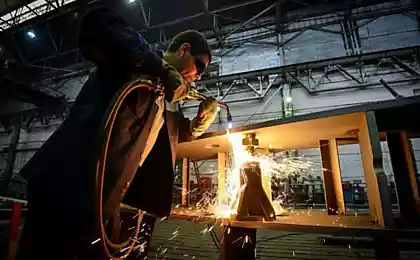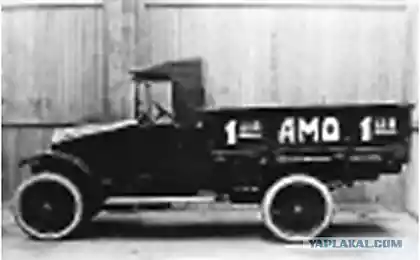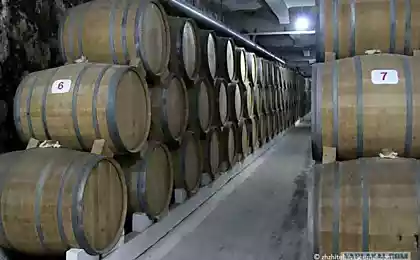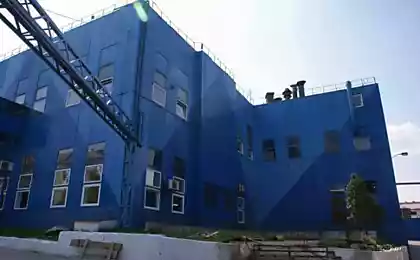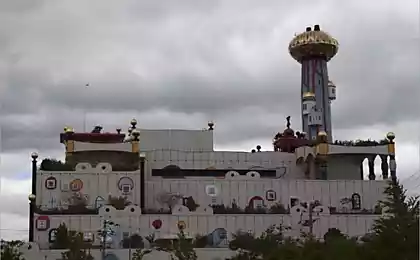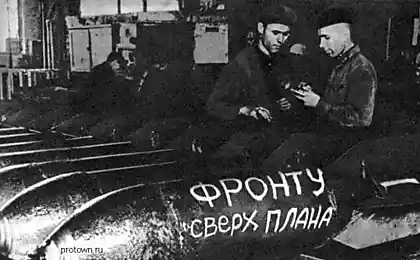973
298 years ago founded the Tula Arms Plant
13 photos Author: judasprist
February 26, 1712 by decree of Peter I founded the Tula Arms Plant. Tula was the capital of the Russian weapons. Peter I, who knew the price of a gunsmith, patronized Tula, allocating funds for the development of production.
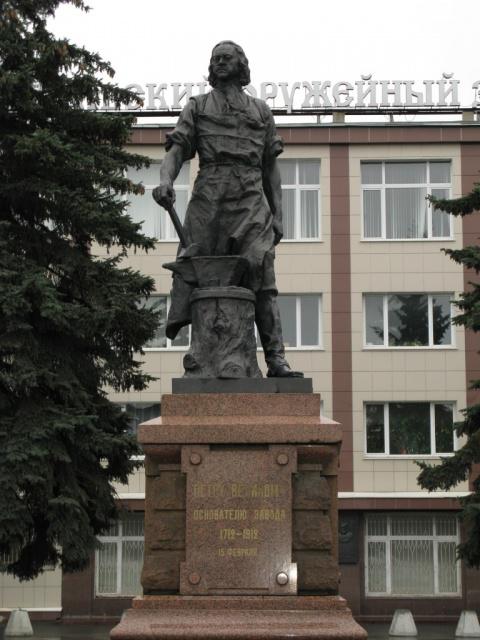
The company was equipped with a progressive for that time facilities: water machines, "trochanteric" machines for drilling shafts, grapes, hammers, machines for "scrubbing" - the exterior and interior of trunks. For the first time in the production of steel machinery used for calibration gauges.
Application of the most advanced technologies of the 18th century considerably improve the quality of weapons, and as a result - in one of the royal decrees Tula weapons has been recognized as the standard.

In 1720, for the Russian army were produced 22 thousand reliable, light infantry and dragoon rifles, pistols with flintlock, and since 1749 began mass production of bladed weapons - swords, sabers, broadswords, swords.
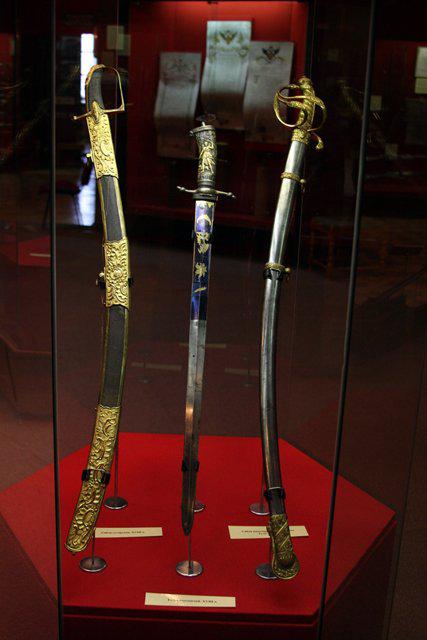
In the second half of the 18th century accounts for the flourishing of the Tula weapon skill. Unusually, the demand for artistically decorated Tula arms and particularity of the product. A unique, surprising in its elegance invention Tula - "diamond face" on the metal, and many other secrets finishing of metal and wood have their roots precisely in this era.
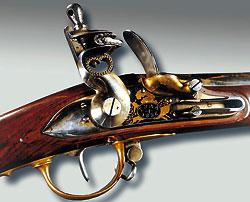
Reconstructed in the 19th Century Tula Arms Plant became one of the best companies in Europe.
In the 20th century, the factory continued to operate and develop, preserving traditions and developing new directions. In 1941-1945, working under the motto "All for the front, everything for victory", Tula gunsmiths produced autoloading rifle SVT-38/40, aircraft gun "ShVAK" Nagan revolver and pistol Tokarev.
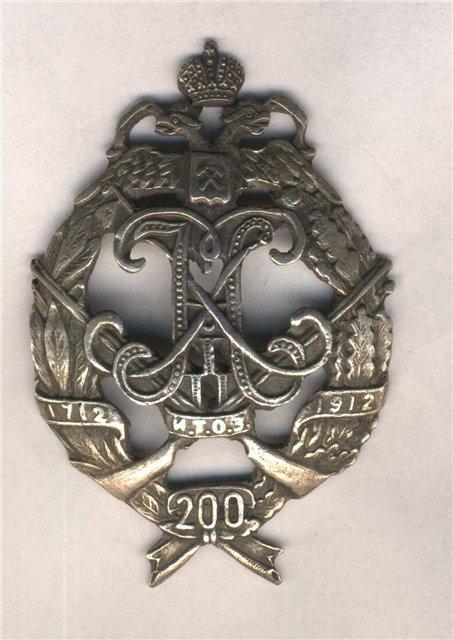
Self-loading rifle Tokarev SVT-38/40. Nagan revolver

gunsmiths repair weapons during the siege of Tula.
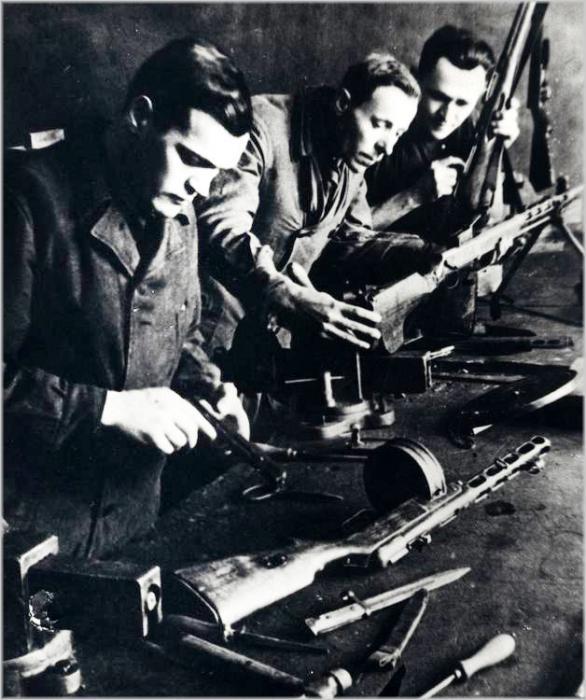
Tula Tokarev
The plant has traveled a long and glorious path. A new generation of artists has created his own unique style, which absorbed all the well-known fact in opyzheynom artistic means, using different materials - gold, silver, ivory, mother of pearl. Lefty traditions alive to this day.
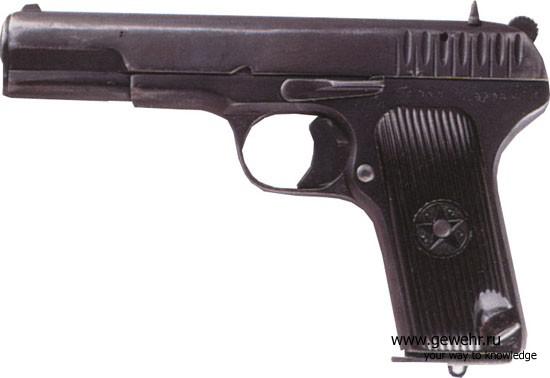
Compact competitor of Tula gunsmiths Kalashnikov sub-machine gun PP-2000.
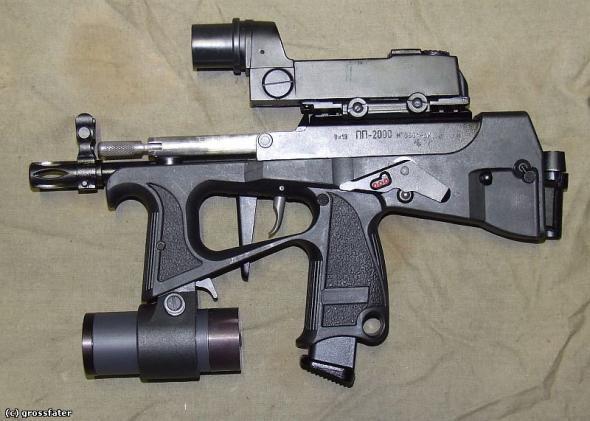
Tula Arms Plant
Today, the history of the Tula arms production goes in those days, when the protection of Russian borders from nomad raids residents of Tula did not have weapons. It is produced in Moscow, and deliver it was a matter of long and troublesome. Therefore, the decree of Tsar Fyodor, it was decided to establish an arms deal directly in Tula. In the future, it is largely determined the fate of the city, giving him the glory of the weapons of the Russian capital.
In the history of Tula was greatly influenced by Peter I, he knew and appreciated the weapon on February 26 marks 295 years since the establishment of the Tula arms factory. masters. In 1695, Sovereign's order amounted to two thousand rifles. In 1706 in the Tula district it was built a wooden weapon yard with forges and workmen huts, weapons and output increased to 15 thousand a year.
In 1712 by decree of Peter I in the district was founded the first Russian state arms factory. In his decree of the emperor commanded: & quot; ... for the better in the rifle case method at the armory settlement, Fine convenient place to build the plants, which would be possible guns fuzei pistols drilling and scour and swords and knives sharpening water & quot ;. Decree of the matter is put on the state basis, and weapons courtyard is transformed into a state-owned enterprise.
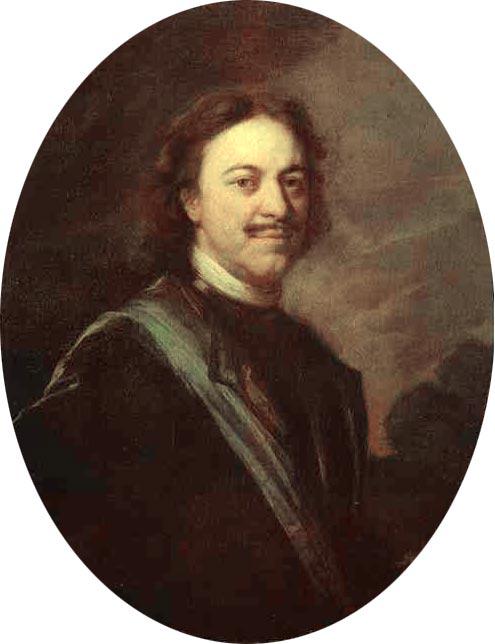
C first days of the arms factory produced a full range of small arms and bladed weapons for the Russian army. Tula weapon has always been known for its quality. Even Catherine II when visiting the plant celebrated the "great masters of the hunt and the ability, the product of which all parts are not inferior to the most infamous of these things like foreign artists." The Mandate Commission of the Tula Arms Plant said: "The test proved that the empire of our many happy and glorious for completed Wars defended gun case of this plant, nedoznav lack of any number of masters and workers, or the art of them, from time to time continue to increase." < br />
Widespread use in the Tula Arms Plant was Bulat. Cast damask produced by melting in a lidded crucible of pure iron ore and coal - the process took hours. Welding damask (Damascus steel) obtained by welding steel and iron bars. From good cutting cast Bulat made mainly blades. From the welded Damascus steel that can make a strong heat (necessary for the welding of trunks), made firearms. Although the welded Damascus steel was patented by William Dyupeynom in 1798, Tula products "red iron" (as it was called then welded Damascus steel) made in the middle of the XVIII century. Many artists have tried to improve the manufacturing plant - and there were such ideas in the XVIII and XIX centuries in. In the XVIII century James Batishchev set at the factory for wiping the car trunk, which made it possible to whiten 16 barrels per day, while for manual wiping a day made only two trunk. At the beginning of the XIX century gunsmith V.A.Pastuhov held a press for stamping parts of the castle. In 1810, a mechanic P.Zahavo designed a machine for drilling the second and final finishing of the barrel, and in 1823 - a machine for finishing the outer surface.
One of the most famous masters and innovators Tula arms factory was Ivan Pauline, who constructed a flintlock pistol with box stores in the six bullets, was placed in the gun handle. Compared with the normal sample combatant gun last quarter of the XVIII century Gun Pauline had smaller size and weight, as well as other appearance. However, the main merit of the master was that in fact the first time in the history of Russian weapons in the gun Pauline solved the problem of setting up shop multiply charged handguns. State-owned gun box Polina includes the whole mechanism of charge; gunpowder and bullet shops were located in wooden handle. Thus, even a century before S.Mosina, the inventor of the Russian magazine rifle, Tula gunsmith Ivan Pauline worked on the problem of gun shops.
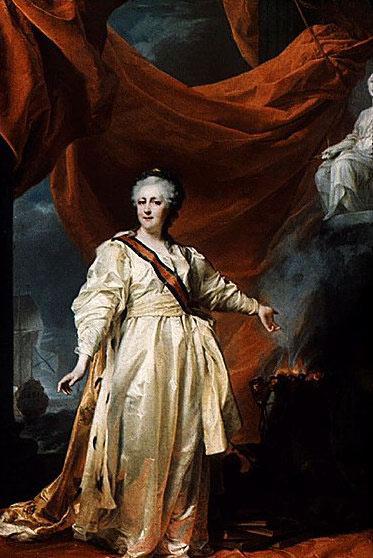
S.Mosin
Due to the mechanization of production at the Tula arms factory in the first third of the XIX century it was achieved almost complete interchangeability of parts of weapons. At the World Exhibition in Paris in 1900 for its quality Tula weapon was awarded the Diploma of Honor and the Great Gold Medal.
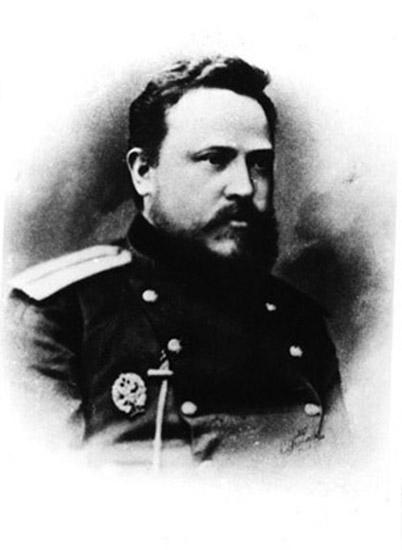
Source:
February 26, 1712 by decree of Peter I founded the Tula Arms Plant. Tula was the capital of the Russian weapons. Peter I, who knew the price of a gunsmith, patronized Tula, allocating funds for the development of production.

The company was equipped with a progressive for that time facilities: water machines, "trochanteric" machines for drilling shafts, grapes, hammers, machines for "scrubbing" - the exterior and interior of trunks. For the first time in the production of steel machinery used for calibration gauges.
Application of the most advanced technologies of the 18th century considerably improve the quality of weapons, and as a result - in one of the royal decrees Tula weapons has been recognized as the standard.

In 1720, for the Russian army were produced 22 thousand reliable, light infantry and dragoon rifles, pistols with flintlock, and since 1749 began mass production of bladed weapons - swords, sabers, broadswords, swords.

In the second half of the 18th century accounts for the flourishing of the Tula weapon skill. Unusually, the demand for artistically decorated Tula arms and particularity of the product. A unique, surprising in its elegance invention Tula - "diamond face" on the metal, and many other secrets finishing of metal and wood have their roots precisely in this era.

Reconstructed in the 19th Century Tula Arms Plant became one of the best companies in Europe.
In the 20th century, the factory continued to operate and develop, preserving traditions and developing new directions. In 1941-1945, working under the motto "All for the front, everything for victory", Tula gunsmiths produced autoloading rifle SVT-38/40, aircraft gun "ShVAK" Nagan revolver and pistol Tokarev.

Self-loading rifle Tokarev SVT-38/40. Nagan revolver

gunsmiths repair weapons during the siege of Tula.

Tula Tokarev
The plant has traveled a long and glorious path. A new generation of artists has created his own unique style, which absorbed all the well-known fact in opyzheynom artistic means, using different materials - gold, silver, ivory, mother of pearl. Lefty traditions alive to this day.

Compact competitor of Tula gunsmiths Kalashnikov sub-machine gun PP-2000.

Tula Arms Plant
Today, the history of the Tula arms production goes in those days, when the protection of Russian borders from nomad raids residents of Tula did not have weapons. It is produced in Moscow, and deliver it was a matter of long and troublesome. Therefore, the decree of Tsar Fyodor, it was decided to establish an arms deal directly in Tula. In the future, it is largely determined the fate of the city, giving him the glory of the weapons of the Russian capital.
In the history of Tula was greatly influenced by Peter I, he knew and appreciated the weapon on February 26 marks 295 years since the establishment of the Tula arms factory. masters. In 1695, Sovereign's order amounted to two thousand rifles. In 1706 in the Tula district it was built a wooden weapon yard with forges and workmen huts, weapons and output increased to 15 thousand a year.
In 1712 by decree of Peter I in the district was founded the first Russian state arms factory. In his decree of the emperor commanded: & quot; ... for the better in the rifle case method at the armory settlement, Fine convenient place to build the plants, which would be possible guns fuzei pistols drilling and scour and swords and knives sharpening water & quot ;. Decree of the matter is put on the state basis, and weapons courtyard is transformed into a state-owned enterprise.

C first days of the arms factory produced a full range of small arms and bladed weapons for the Russian army. Tula weapon has always been known for its quality. Even Catherine II when visiting the plant celebrated the "great masters of the hunt and the ability, the product of which all parts are not inferior to the most infamous of these things like foreign artists." The Mandate Commission of the Tula Arms Plant said: "The test proved that the empire of our many happy and glorious for completed Wars defended gun case of this plant, nedoznav lack of any number of masters and workers, or the art of them, from time to time continue to increase." < br />
Widespread use in the Tula Arms Plant was Bulat. Cast damask produced by melting in a lidded crucible of pure iron ore and coal - the process took hours. Welding damask (Damascus steel) obtained by welding steel and iron bars. From good cutting cast Bulat made mainly blades. From the welded Damascus steel that can make a strong heat (necessary for the welding of trunks), made firearms. Although the welded Damascus steel was patented by William Dyupeynom in 1798, Tula products "red iron" (as it was called then welded Damascus steel) made in the middle of the XVIII century. Many artists have tried to improve the manufacturing plant - and there were such ideas in the XVIII and XIX centuries in. In the XVIII century James Batishchev set at the factory for wiping the car trunk, which made it possible to whiten 16 barrels per day, while for manual wiping a day made only two trunk. At the beginning of the XIX century gunsmith V.A.Pastuhov held a press for stamping parts of the castle. In 1810, a mechanic P.Zahavo designed a machine for drilling the second and final finishing of the barrel, and in 1823 - a machine for finishing the outer surface.
One of the most famous masters and innovators Tula arms factory was Ivan Pauline, who constructed a flintlock pistol with box stores in the six bullets, was placed in the gun handle. Compared with the normal sample combatant gun last quarter of the XVIII century Gun Pauline had smaller size and weight, as well as other appearance. However, the main merit of the master was that in fact the first time in the history of Russian weapons in the gun Pauline solved the problem of setting up shop multiply charged handguns. State-owned gun box Polina includes the whole mechanism of charge; gunpowder and bullet shops were located in wooden handle. Thus, even a century before S.Mosina, the inventor of the Russian magazine rifle, Tula gunsmith Ivan Pauline worked on the problem of gun shops.

S.Mosin
Due to the mechanization of production at the Tula arms factory in the first third of the XIX century it was achieved almost complete interchangeability of parts of weapons. At the World Exhibition in Paris in 1900 for its quality Tula weapon was awarded the Diploma of Honor and the Great Gold Medal.

Source:


